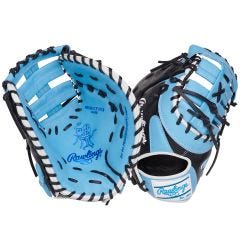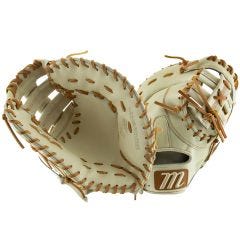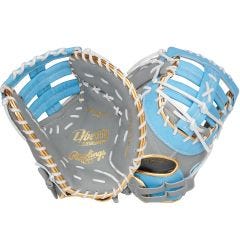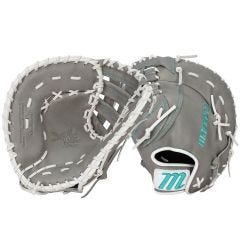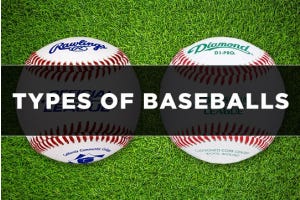Playing First Base: Learn Footwork, Drills, Positioning and More
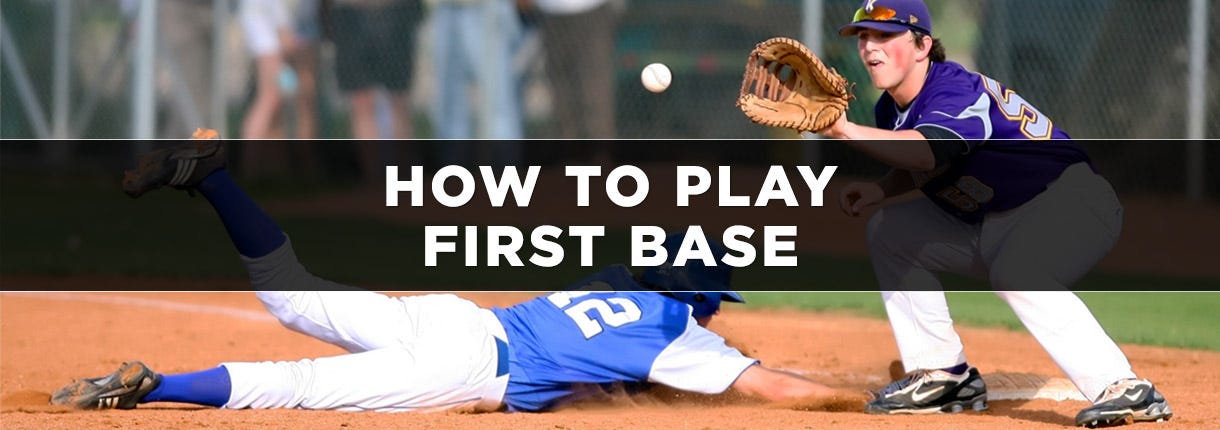
When playing first base, you must be able to move and react quickly around the base, sometimes adjusting your feet depending on the accuracy of the throw you are catching. Typically, first basemen are bigger in stature and play their biggest role at the plate. However, having a quality first baseman allows a team to avoid giving away outs on a routine basis. Below we will discuss certain responsibilities of a first baseman and provide some tips and tricks to hopefully help you learn the ins and outs of the position.
In this guide, we will cover:
Responsibilities and Skills of a First Baseman
At the surface level, the first base appears to be one of the simpler spots on the diamond. Most people only view the first basemen as the person who catches throws from the infielders and the occasional ground ball. However, first basemen have many important responsibilities you might not realize. Let's check them all out!
First Baseman’s Defensive Positioning
No Runners on Base
- Play Off the Bag: Position yourself off the bag, ready for balls to hit your way.
- Adjust Position: Change depth or shift right and left before each pitch to improve your play opportunities.
- Move to the Bag: Quickly head to the bag to receive a throw if the ball is not hit to you.
Runner on First
- Hold the Runner: Stay on the base to prevent the runner from stealing and prepare for a pick-off throw.
- Adjust Responsibilities: If the pitcher delivers to the plate, call out if the runner attempts to steal.
- React to the Hit: Hop off the bag and prepare for a hit, then return to the bag to receive a throw if the ball is hit to another infielder.
- Be Aware of Back-Picks: Stay alert for a potential back-pick attempt by the catcher.
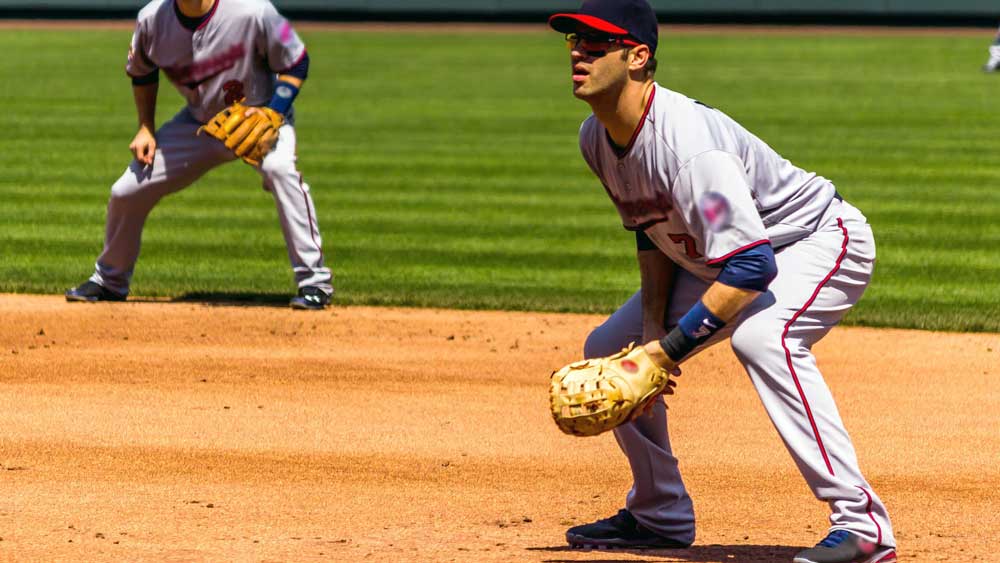
Fielding a Ground Ball with a Runner on First
Throw to Second Base:
- Aim to start a double play.
- Ensure the throw avoids hitting the runner.
- Quickly return to the bag to receive the return throw.
Step on First Base:
- Get the force out at first.
- Optionally, throw to second for a tag attempt on the runner.
With Bases Loaded:
Throw Home:
- Attempt to get the force out at home plate.
- Quickly cover first base to receive a return throw from the catcher.
Starting a Double Play
With a Runner on First
Throw to Second Base:
- Start a double play by aiming for second base.
- Ensure the throw avoids hitting the runner and quickly return to the first base to receive the return throw.
Step on First Base:
- Get the force out at first base.
- You can still throw to second for a tag attempt on the runner.
With Bases Loaded
Throw Home:
- Attempt to get the force out at home plate.
- Quickly cover first base to receive a return throw from the catcher.
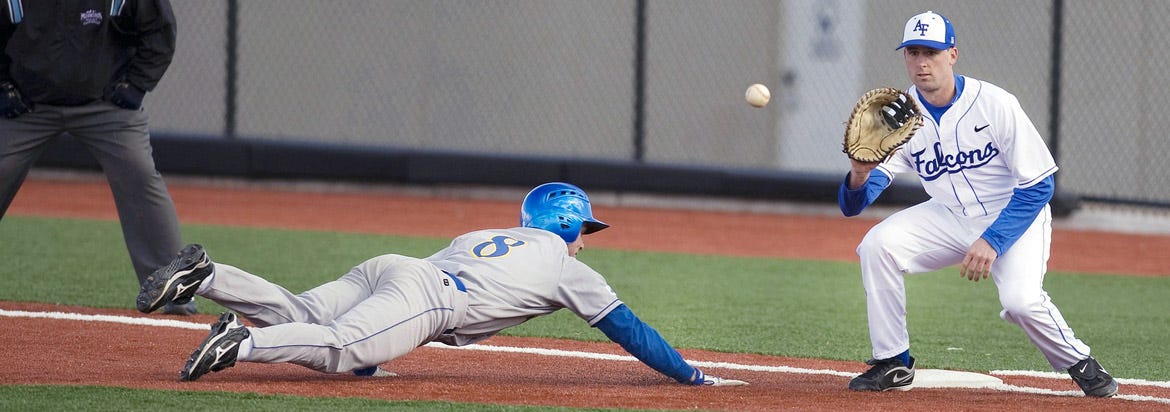
Feeding the Pitcher
>Bunt or Ground Ball to First Base
>>Feed the Pitcher:
- Deliver the ball in stride, ideally using an underhand throw, to make it easier for the pitcher to step on first base and avoid the hitter.
- If the ball takes you far off the bag, make a strong throw to the pitcher covering first base.
Fielding Pop-Ups
>Handling Pop-Ups:
- Avoiding First Base: Catch pop-ups while being mindful not to collide with first base.
- Foul Territory: Most pop-ups caught by first basemen are in foul territory.
- Call Off Pitcher/Catcher: Call off the pitcher or catcher if you have a better chance of making the catch, as it’s easier for you to move into position than for them.
Catching Throws
>Basic Technique:
- Foot Placement: Keep your right foot on the bag if you’re a righty, and your left foot if you’re a lefty.
- Catching the Throw: Aim to catch throws at your chest; scoop low throws with a specially designed glove.
- Stretching: Extend your body to catch off-target throws while maintaining your foot on the bag.
- Flexibility: Being flexible enhances your range and helps secure the out on close plays.
The Importance of a First Base Mitt
First base gloves, also known as first base mitts, are specially designed to meet the specific needs of players at the first base position. First basemen often have to scoop low throws in the dirt from other infielders, so these gloves are designed with features to help keep the ball secure.
Comparison: First Baseman's Mitt vs. Conventnional Infield Glove
| Feature | First Baseman’s Mitt | Conventional Infield Glove |
| Edge Design |
|
|
| Webbing |
|
|
| Ball Control |
|
|
| Padding |
|
|
| Primary Use |
|
|
Unlike a conventional infielder’s glove, a first baseman's mitt features a continuous round edge to improve the chances of scooping balls thrown in the dirt. This rounded edge serves as a funnel, guiding any off-target throws directly into the glove's webbing. First-base mitts have the deepest webbing of any glove on the field. Normally a single post or H-web, the deep web allows the player to control the ball when scooping and catching. Finally, these mitts have extra padding to protect the hand from the sting of hard-thrown balls.
To view our complete collection of first-base mitts, click here.
Best Baseball & Softball Firstbase Mitts
Best Baseball First Base Mitts
Mizuno Pro Select GPS-30 12.5" Baseball First Base Mitt
Key Features:
- Premium Steerhide
- 3D Silicone Logo
- Quicker break-in time
Overview:
This mitt exemplifies high-level craftsmanship from quality materials that athletes have come to expect from Mizuno. Designed with a perfect balance of durability and comfort, this glove features premium steerhide leather that boasts a quicker break-in time without compromising structural integrity. The thoughtful design ensures a swift adaptation to the contours of your hand, providing a personalized fit while delivering long-lasting performance.
Rawlings Heart of the Hide PRORDCT-10C 13" Baseball First Base Mitt - 2025 Model
Key Features:
- Heart of the Hide® leather
- DCT pattern
- 13”
Overview:
With its striking Columbia blue and black colorway, featuring a Columbia blue Oval-R logo and a Rawlings patch, this glove not only delivers on style but also on performance. Crafted from ultra-premium Heart of the Hide® leather, known for its durability and pro-level quality, this mitt offers a secure and reliable fit. The DCT pattern ensures a tight squeeze, while the single-post, double-bar web creates a deep pocket perfect for snagging every throw.
Marucci Capitol 39S1 13" Baseball First Base Mitt
Key Features:
- Japanese-tanned USA Kip
- cabretta sheepskin lining
- 13”
Overview:
Crafted for elite performance, this glove features premium Japanese-tanned USA Kip leather for the perfect blend of structure and lightweight feel. A cabretta sheepskin lining offers luxurious comfort, while a moisture-wicking mesh wrist lining with dual-density memory foam padding ensures a secure fit. Finished with professional-grade rawhide laces, this glove delivers maximum durability and tear resistance.
Best Softball First Base Mitts
Rawlings Liberty Advanced Colorsync 4.0 RLADCTSBGCB 13" Fastpitch Softball First Base Mitt
Key Features:
- Poron XRD Palm Padding
- full-grain leather
- 13”
Overview:
Constructed from high-quality, full-grain leather, this glove provides exceptional durability and performance for fast-pitch players. Its large, deep pocket and reinforced split-post double-bar web are designed specifically for first basemen, making it perfect for securing tough throws and digging out balls in the dirt. The soft leather construction offers a game-ready feel and allows for a quick, easy break-in. In addition, the adjustable Pull Strap back ensures a custom fit for optimal comfort throughout every game. The Poron XRD palm padding absorbs impact, reducing sting from hard-hit balls.
Marucci Palmetto 39S2 13" Fastpitch Softball First Base Mitt - 2025 Model
Key Features:
- 13”
- Tight-Grain Steerhide Leather Shell
- M-Type Fit System
Overview:
This mitt features the innovative M Type fit system, complete with integrated thumb and pinky sleeves and enhanced cushioning for maximum comfort and feel during play. Designed specifically for fastpitch players, its H-Web design and pro-style patterns ensure optimal performance. Crafted from premium, tight-grain steerhide leather, it boasts a supple palm lining with extra cushioning, deep glove depth, and professional-grade rawhide laces for exceptional durability. The tapered hand stall provides a snug fit and improved fielding control, while the adjustable wrist closure ensures a secure fit.
Easton Color Splash PCFP13-10T 13" Fastpitch Softball First Base Mitt
Key Features:
- 13”
- Pull-Strap Back
- Premium Reserve USA Steerhide
Overview:
Crafted from premium USA steerhide leather, this mitt is designed to maintain its shape and endure the toughest plays. Featuring Easton's Quantum Closure System, expect a snug fit and precise control with every catch. The 13” single-post double-bar web, adorned with eye-catching welting and binding, ensures you stand out on the field.
How to Play First Base FAQs
What is the first base in baseball?
The first base in baseball is one of the four bases that players must touch in sequence to score a run, located on the right side of the diamond. It’s also a defensive position where the first baseman plays to catch throws from other infielders and make outs at the base.
How to play first-base softball?
To play first base in softball, position yourself close to the base, be ready to catch throws from infielders, and cover the base for force outs. Use a first baseman’s mitt for better control and to scoop balls thrown in the dirt.
How do you handle low or errant throws to first base?
For low or errant throws, use a scoop technique to lift the ball from the dirt while keeping your foot on the base. Position your glove to trap the ball and maintain balance to secure the out.
What is the best way to hold a runner on first base?
To hold a runner on first base, position yourself on the base with a slight lean towards the runner, keeping your glove and body close to the base to make it harder for the runner to steal. Maintain a quick, watchful stance to react to pick-off attempts or stolen base attempts.
When should a first baseman charge on a bunt or slow ground ball?
A first baseman should charge on a bunt or slow ground ball when the ball is within a reasonable distance to reach and make a play on the runner. This allows you to quickly field the ball and make a throw to get the out at first base.







